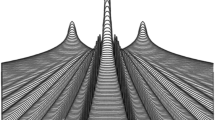Abstract
Bell's theorem depends crucially on counterfactual reasoning, and is mistakenly interpreted as ruling out a local explanation for the correlations which can be observed between the results of measurements performed on spatially-separated quantum systems. But in fact the Everett interpretation of quantum mechanics, in the Heisenberg picture, provides an alternative local explanation for such correlations. Measurement-type interactions lead, not to many worlds but, rather, to many local copies of experimental systems and the observers who measure their properties. Transformations of the Heisenberg-picture operators corresponding to the properties of these systems and observers, induced by measurement interactions, “label” each copy and provide the mechanism which, e. g., ensures that each copy of one of the observers in an EPRB or GHZM experiment will only interact with the “correct” copy of the other observer(s). The conceptual problem of nonlocality is thus replaced with a conceptual problem of proliferating labels, as correlated systems and observers undergo measurement-type interactions with newly-encountered objects and instruments; it is suggested that this problem may be resolved by considering quantum field theory rather than the quantum mechanics of particles.
Similar content being viewed by others
REFERENCES
H. Everett III, “‘Relative state’ formulation of quantum mechanics,” Rev. Mod. Phys. 29, 454-462 (1957); reprinted in B. S. DeWitt and N. Graham, eds., The Many-Worlds Interpretation of Quantum Mechanics (Princeton University Press, Princeton, NJ, 1973).
B. S. DeWitt, “Quantum mechanics and reality,” Phys. Today 32, 155-165 (1970).
D. N. Page, “The Einstein-Podolsky-Rosen physical reality is completely described by quantum mechanics,” Phys. Lett. 91A, 57-60 (1982).
F. J. Tipler, “The many-worlds interpretation of quantum mechanics in quantum cosmology,” in R. Penrose and C. J. Isham, Quantum Concepts in Space and Time (Oxford University Press, New York, 1986).
F. J. Tipler, “Does quantum nonlocality exist? Bell's theorem and the many-worlds interpretation,” quant-ph/0003146.
D. Albert and B. Loewer, “Interpreting the many-worlds interpretation,” Synthese 77, 195-213 (1988).
D. Z. Albert, Quantum Mechanics and Experience (Harvard University Press, Cambridge, MA, 1992).
L. Vaidman, “On the paradoxical aspects of new quantum experiments,” in D. Hull et al., eds., PSA 1994: Proceedings of the 1994 Biennial Meeting of the Philosophy of Science Association 1, 211-217 (Philosophy of Science Association, East Lansing, MI, 1994).
L. Vaidman, “On schizophrenic experiences of the neutron or why we should believe in the many-worlds interpretation of quantum theory,” Int. Stud. Phil. Sci. 12, 245-261 (1998); quant-ph/9609006.
L. Vaidman, “The many-worlds interpretation of quantum mechanics,” http://www.tau.ac.il/ vaidman/mwi/mwstr.html (1999).
M. C. Price, “The Everett FAQ,” http://www.hedweb.com/manworld.htm (1995).
M. Lockwood, “‘Many minds’ interpretations of quantum mechanics,” Brit. J. Phil. Sci. 47, 159-188 (1996).
D. Deutsch, “Reply to Lockwood,” Brit. J. Phil. Sci. 47 222-228 (1996).
D. Deutsch, and P. Hayden, “Information flow in entangled quantum systems,” Proc. R. Soc. Lond. A456, 1759-1774, (2000); quant-ph/9906007.
J. S. Bell, “On the Einstein-Podolsky-Rosen paradox,” Physics 1, 195-200, (1964). Reprinted in J. S. Bell, Speakable and Unspeakable in Quantum Mechanics (Cambridge University Press, Cambridge, 1987).
W. G. Farris, “Probability in quantum mechanics,” Appendix to D. Wick, The Infamous Boundary: Seven Decades of Heresy in Quantum Physics (Springer, New York, 1995).
D. Bohm, Quantum Theory (Prentice-Hall, Englewood Cliffs, NJ, 1951).
A. Einstein, B. Podolsky, and N. Rosen, “Can quantum-mechanical description of reality be considered complete?,” Phys. Rev. 47, 777-780 (1935).
N. D. Mermin, “Spooky actions at a distance: mysteries of the quantum theory,” in The Great Ideas Today (Encyclopedia Britannica, 1988), reprinted in N. D. Mermin, Boojums All The Way Through: Communicating Science in a Prosaic Age (Cambridge University Press, Cambridge, 1990).
A. Aspect, J. Dalibard, and G. Roger, “Experimental tests of Bell's inequalities using time-varying analyzers,” Phys. Rev. Lett. 47, 1804-1807 (1982).
G. Weihs, T. Jennewien, C. Simon, H. Weinfurter, and A. Zeilinger, “Violation of Bell's inequality under strict Einstein locality conditions,” Phys. Rev. Lett. 81, 5039-5043 (1998).
N. D. Mermin, “Quantum mysteries revisited,” Am. J. Phys. 58 731-734 (1990).
N. D. Mermin, “What's wrong with these elements of reality?,” Physics Today, June 1990, 9-11.
D. M. Greenberger, M. Horne, and A. Zeilinger, “Going beyond Bell's theorem,” in M. Kafatos, ed., Bell's Theorem, Quantum Theory, and Conceptions of the Universe (Kluwer Academic, Dordrecht, The Netherlands, 1989).
D. M. Greenberger, M. Horne, A. Shimony, and A. Zeilinger, “Bell's theorem without inequalities,” Am. J. Phys. 58, 1131-1143 (1990).
B. d'Espagnat, Veiled Reality: An Analysis of Present-Day Quantum Mechanical Concepts (Addison-Wesley, Reading, MA, 1995), Section 10.8.
L. E. Ballentine, “Can the statistical postulate of quantum theory be derived?—a critique of the many-universes interpretation,” Found. Phys. 3, 229-240 (1973).
N. Graham, “The measurement of relative frequency,” in B. S. DeWitt and N. Graham, eds., The Many Worlds Interpretation of Quantum Mechanics (Princeton University Press, Princeton, NJ, 1973).
D. Deutsch, “Quantum theory as a universal physical theory,” Int. J. Theor. Phys. 24, 1-41 (1985).
B. DeWitt, “The quantum mechanics of isolated systems,” Int. J. Mod. Phys. A13, 1881-1916 (1998).
N. Bohr, “Can quantum-mechanical description of reality be considered complete?” Phys. Rev. 48, 696-702 (1935), quoted in Chap. 16 of J. S. Bell, Speakable and Unspeakable in Quantum Mechanics (Cambridge University Press, Cambridge, 1987).
D. L. Zhou, S. X. Yu, and C. P. Sun, “Idealization second quantization of composite particles,” quant-ph/0012080.
Author information
Authors and Affiliations
Rights and permissions
About this article
Cite this article
Rubin, M.A. Locality in the Everett Interpretation of Heisenberg-Picture Quantum Mechanics. Found Phys Lett 14, 301–322 (2001). https://doi.org/10.1023/A:1012357515678
Published:
Issue Date:
DOI: https://doi.org/10.1023/A:1012357515678




